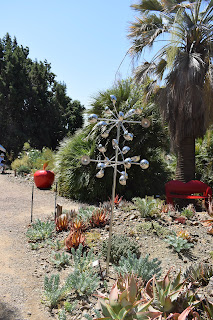I finally made my first visit to the iconic Ruth Bancroft Garden in Walnut Creek last week. A world renowned national treasure, this 3.5 acre garden is filled with a dazzling array of succulents and dry garden plants from around the world. The latter group includes a dazzling sampling of Agaves and Yuccas. I took photos that day so thought I'd share them here.
Agave species. These huge silvery agaves greet the visitor near the entrance. Their size and color make them an eye-catching specimen. This may be A. franzosinii.
As mentioned, there are many yuccas in the garden and here is one in bloom. Unidentified but one of a group of tall yuccas.
Puya coerulea var. monteroana. Hailing from central Chile, the dramatic flowers on this clumping plant attract local hummingbirds. Below is a photo of the huge clump it has formed in the Garden. Very drought tolerant and adaptable to different environments.
Salvia pachyphylla.With lovely burgundy bracts and purple flowers, this native sage found growing in the mountains of Southern California is also known as Blue Flame or Giant Purple sage. Usually a neat 2' x 2' it can make itself at home in any dry garden bed.
Jubaea chilensis. Known as Chilean Wine palm, this relatively cold hardy palm has a trunk that can span 4-6' in diameter. It tops out at 80' tall. The common name owes to the sugars found within its trunk being fermented by locals to make wine.
You'd be forgiven for exclaiming surprise at this plant's ID. It's a Grevillea petrophiloides 'Big Bird.' Known as 'Pink Pokers' for its tufts of pink flowers that rise above the foliage (see photo below), it forms a 4-6' high bush and like most Grevilleas is very drought tolerant. Native to Australia.
This unusual Aloe (A. woodii) has fuzzy cream-colored flowers that rise in slender candelabras above the leaves.
This wide angle view is of a bed near the back end of the Garden. Hopefully it helps to give an idea of the scale of the Garden.
Ponytail Palns (Beaucarnea recurvata) may be a charming little houseplant but in the wild they can get huge. Mature specimens feature especially fat trunks, making this an easy to grow caudiciform. Below is the whole plant with its signature 'mophead' of leaves.
There was plenty of sculpture in the garden, in advance of a summer show. Here my friend takes a moment's pause on a metal bench fashioned out of an old car.
Sometimes recent plantings give the effect of the plants having just popped out of the ground, as is the case here with these blue agaves.
Several Agave species send up tall, architectural flower spikes. I'm not 100% certain but I believe this spike is from an Agave parrasana. It takes awhile to bloom but is well worth the wait.
This bed of low growing succulents reminded me of an Exhibitor's display at a SF Garden Show, where they used succulents to simulate an 'underwater garden.' Surprisingly, many succulents do remind one of things like sea anemones, starfish etc.
Arctostaphylos 'Ruth Bancroft.' This accidental hybrid has matured into a fantastic tree and on this visit the bark had shed its outer layer, leaving a smooth and brilliant reddish-brown skin.
Here's more of the sculpture found throughout the garden.
This Grevillea 'King's Fire' was in bloom on our visit, much to our mutual delight.
No one seems to know what this semi-succulent ground cover plant is but it was in bloom throughout its many occurrences in the garden. It features delicate sprays of tiny lavender flowers. Charming.
Brachychiton species. This may be a B. rupestris but in any case it too is a caudiciform, here showing off its fattening trunk.
These fan palms have yet to be identified by my sources but they are certainly one of the striking beauties in the Garden.
Timing is everything. We arrived at the right time to see this Erythrina x bidwillii in full bloom. Hardy for a Coral tree, it doesn't get too big (8'x10') and as you can see, gets nice and bushy. A real showstopper!
Here's another Brachychiton and here you see more easily the fat trunk.
We were lucky to be at the Garden when the Chilopsis linearis trees were in bloom. Featuring 'pretty-in-pink' snapdragon-like flowers, it makes for quite a summer show. Called Desert Willow for its narrow willow-like leaves, this southwest U.S. native is very drought tolerant.
Opuntia species. Prickly Pear cactus is very easy to ID, with its flat paddle-like leaves. They can over time get huge, as evidenced here, and of course have exotically beautiful flowers and edible fruit.
The Ruth Bancroft is famous for their Parkinsonia trees. The selection 'Desert Museum' is featured throughout the garden. They were were in full glorious bloom on the day we visited. Delicate yet sturdy, they are showy even at a distance.
Here's another mystery Agave with a mammoth flower spike. It reminds me of a Dr. Seuss plant and the flowering spike a multi-level treehouse!
Athanasia species (probably A. acerosa). This handsome shrub, with its Euryops-like foliage, makes a bold statement in the Garden. This South African native, sometimes called Coulter bush, offers needle-like silvery foliage and in late spring flat cymes of bright yellow flowers.
We aren't sure of the species but this Eucalyptus plant already has flat leaves that are a fantastic silver color.
And a South African bulb to end our 'visit.' It's Cyrtanthus obliquus. This Amaryllis family member has large, downward facing tubular flowers, held in small clusters. Fantastic!
Subscribe to:
Post Comments (Atom)
































No comments:
Post a Comment